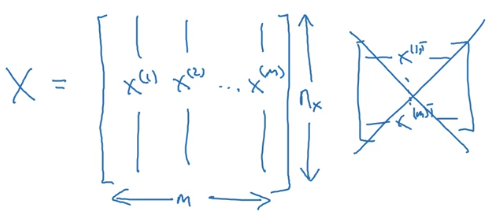Logistic Regression-Cost Fuction
1. 二分类问题
- 样本:
,训练样本包含
个;
- 其中
,表示样本
包含
个特征;
,目标值属于0、1分类;
- 训练数据:
输入神经网络时样本数据的形状:

目标数据的形状:
2. logistic Regression
逻辑回归中,预测值:
其表示为1的概率,取值范围在 之间。 引入Sigmoid函数,预测值:
其中
注意点:函数的一阶导数可以用其自身表示,
这里可以解释梯度消失的问题,当 时,导数最大,但是导数最大为
,这里导数仅为原函数值的0.25倍。 参数梯度下降公式的不断更新,
会变得越来越小,每次迭代参数更新的步伐越来越小,最终接近于0,产生梯度消失的现象。
3. logistic回归 损失函数
Loss function
一般经验来说,使用平方错误(squared error)来衡量Loss Function:
但是,对于logistic regression 来说,一般不适用平方错误来作为Loss Function,这是因为上面的平方错误损失函数一般是非凸函数(non-convex),其在使用低度下降算法的时候,容易得到局部最优解,而不是全局最优解。因此要选择凸函数。
逻辑回归的Loss Function:
- 当
时,
。如果
越接近1,
,表示预测效果越好;如果
越接近0,
,表示预测效果越差;
- 当
时,
。如果
越接近0,
,表示预测效果越好;如果
越接近1,
,表示预测效果越差;
- 我们的目标是最小化样本点的损失Loss Function,损失函数是针对单个样本点的。
Cost function
全部训练数据集的Loss function总和的平均值即为训练集的代价函数(Cost function)。
- Cost function是待求系数w和b的函数;
- 我们的目标就是迭代计算出最佳的w和b的值,最小化Cost function,让其尽可能地接近于0。
################################################################################################################################################
Logistic Regression: Cost Function
To train the parameters 𝑤 and 𝑏, we need to define a cost function. Recap:
𝑦̂(𝑖) = 𝜎(𝑤𝑇𝑥(𝑖) + 𝑏), where 𝜎(𝑧(𝑖))= 1 𝑥(𝑖) the i-th training example 1+ 𝑒−𝑧(𝑖)
𝐺𝑖𝑣𝑒𝑛 {(𝑥(1), 𝑦(1) ), ⋯ , (𝑥(𝑚), 𝑦(𝑚) )}, 𝑤𝑒 𝑤𝑎𝑛𝑡 𝑦̂(𝑖) ≈ 𝑦(𝑖)
Loss (error) function:
The loss function measures the discrepancy between the prediction (𝑦̂(𝑖)) and the desired output (𝑦(𝑖)). In other words, the loss function computes the error for a single training example.
𝐿(𝑦̂(𝑖), 𝑦(𝑖)) = 1 (𝑦̂(𝑖) − 𝑦(𝑖))2 2
𝐿(𝑦̂(𝑖), 𝑦(𝑖)) = −( 𝑦(𝑖) log(𝑦̂(𝑖)) + (1 − 𝑦(𝑖))log(1 − 𝑦̂(𝑖))
-
If 𝑦(𝑖) = 1: 𝐿(𝑦̂(𝑖), 𝑦(𝑖)) = − log(𝑦̂(𝑖)) where log(𝑦̂(𝑖)) and 𝑦̂(𝑖) should be close to 1
-
If 𝑦(𝑖) = 0: 𝐿(𝑦̂(𝑖), 𝑦(𝑖)) = − log(1 − 𝑦̂(𝑖)) where log(1 − 𝑦̂(𝑖)) and 𝑦̂(𝑖) should be close to 0
Cost function
The cost function is the average of the loss function of the entire training set. We are going to find the parameters 𝑤 𝑎𝑛𝑑 𝑏 that minimize the overall cost function.
1𝑚 1𝑚
𝐽(𝑤, 𝑏) = 𝑚 ∑ 𝐿(𝑦̂(𝑖), 𝑦(𝑖)) = − 𝑚 ∑[( 𝑦(𝑖) log(𝑦̂(𝑖)) + (1 − 𝑦(𝑖))log(1 − 𝑦̂(𝑖))]𝑖=1 𝑖=1
注意:
1)定义cost function的目的是为了训练logistic 回归模型的参数 w 和 b
loss fuction 是在单个训练样本上定义的,而cost fuction 是在全体训练样本上定义的

